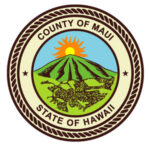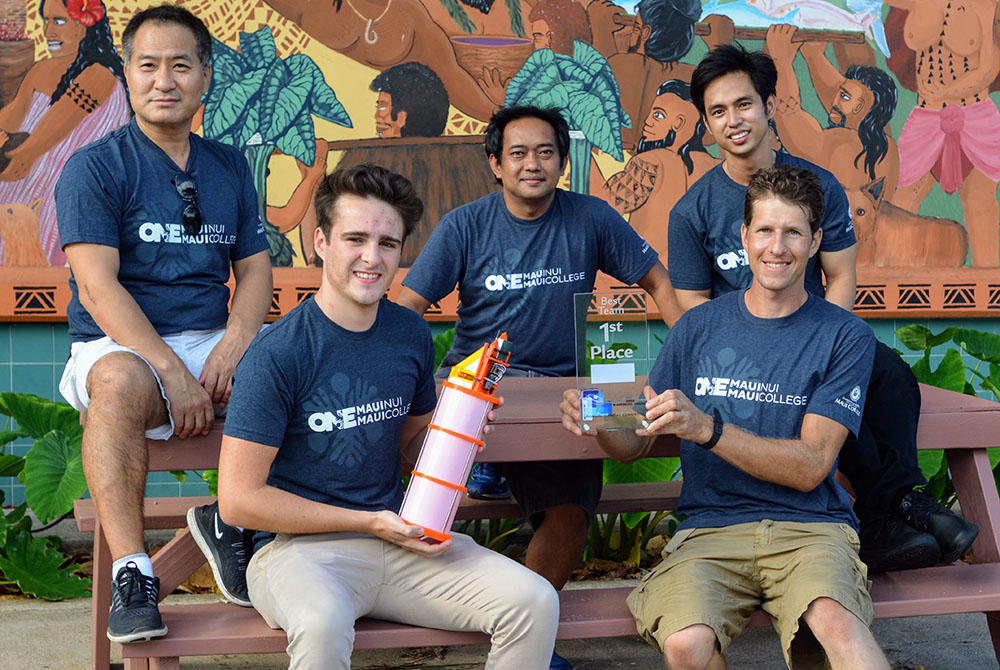
Oct 14, 2020 | Education
The University of Hawai’i Maui College (UHMC) Engineering Technology Program entered two teams in the 2020 International CanSat Competition. Out of 33 teams from more than a dozen countries, Team Onipa’a placed first and Team Paka’a placed 23rd. The competition required teams to design, build and launch a container holding a science payload. The annual event was organized by the American Astronautical Society to inspire future engineers seeking creative solutions, and the UHMC teams were sponsored by the NASA Hawaii Space Grant Consortium.

“The CanSat competition was designed to reflect, on a small scale, a typical NASA aerospace program,” said faculty advisor Dr. Jung Park, Associate Professor in the UHMC Engineering Technology Program and Associate Director of the NASA Hawai’i Space Grant Consortium. “The challenge included all aspects of research from the preliminary design review to the post mission review, incorporating the telemetry requirements, communications, and autonomous operations. This year’s challenge was to design a glider that is capable of unpowered flight and autonomous navigation, telemetry transmission, and sensor data collection while withstanding the extreme forces of a rocket launch.”
The team’s electronics and ground control station software were designed, fabricated, and confirmed operational in a test environment per CanSat specifications. They designed and 3D-printed the mechanical parts, the close-loop control system, and the Arduino code was written and simulated in Matlab. The results showed that critical payload systems are designed to operate in the conditions outlined in the CanSat Competition Mission Guide.
Onipa’a Team Leader Arthur Agdeppa said, “Each member of my team offered a diverse set of expertise, views, and knowledge, which was optimal to integrate various subsystems of our science payload and container. They took responsibility and pride in their weekly assigned tasks, and they welcomed the CanSat competition opportunity. It pushed us to be creative in our design, be resilient in our failures, and to be team players. One of our project’s external objectives was to promote STEM (science, technology, engineering, mathematics) in our community and gain the confidence of young aspiring engineers. We hope that our winning the competition accomplished just that.”
The CanSat project was an excellent way for us to showcase all that we have learned at UHMC.
Arthur Agdeppa, Team Onipa’a Leader, UHMC Engineering Technology Program
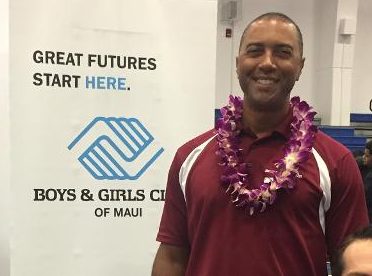
Oct 7, 2020 | Community
 As Maui County faces uncertain times, Boys & Girls Clubs of Maui (BGCM) is still doing whatever it takes to serve youth, families, and the island community. All the clubs are open for Virtual Clubhouse Time, weekdays from 2:00 to 6:00 pm. The live, interactive virtual time adapts the award-winning programs for which BGCM has been known over the last 20 years, into a virtual environment using Zoom virtual meeting software.
As Maui County faces uncertain times, Boys & Girls Clubs of Maui (BGCM) is still doing whatever it takes to serve youth, families, and the island community. All the clubs are open for Virtual Clubhouse Time, weekdays from 2:00 to 6:00 pm. The live, interactive virtual time adapts the award-winning programs for which BGCM has been known over the last 20 years, into a virtual environment using Zoom virtual meeting software.
“We are reaffirming our commitment to island families by opening our Virtual Clubhouse Time to all of Maui’s school-aged keiki, not just our active membership,” said BGCM Director of Operations, Stephen Bennett. “Our goal is to reconnect Maui, so any child from anywhere in Maui County, including Molokai and Lanai can join any clubhouse they wish. We have waived the five dollar annual membership fee until 2021, so there are fewer barriers to learning and participating in fun and engaging activities with their peers.”
Utilizing the Zoom program, BGCM Clubhouse staff are providing their members a full calendar of virtual activities including Power Hour, Project Learn, Smart Moves, Fitness-at-Home, Nutrition-at-Home, Hawaiian Marine Science and Ecosystems, Electronic Smoking Device/Anti-Vaping Education, Bridge2Math mathematics support, Keystone and Torch Club programming, and more. The Zoom platform gives BGCM the capacity to host up to 300 members at a time and provide safety measures, enabling their staff to have control over audio and video connections. Students have great interaction with their friends, seeing and talking with them safely. Also, the staff ensures that appropriate behavior is exhibited and acceptable content is shared. Zoom provides the means to do this, allowing only authorized visitors to join the virtual sessions.
“We want to make sure that we are available to the youth and their families with a sustainable platform that can keep them safe,” said Bennett. “Our programs are specifically designed to offer academic support as well as social interaction. Our staff is committed to taking care of our kids, and they have become virtually strong. Thank you to all of our community partners, supporters, and donors. Stay safe and healthy!”
The Virtual Clubhouse is here and it is fun! We are posting a calendar so you can choose what most interests your child at www.BGCMaui.org
Stephen Bennett, BGCM Director of Operations
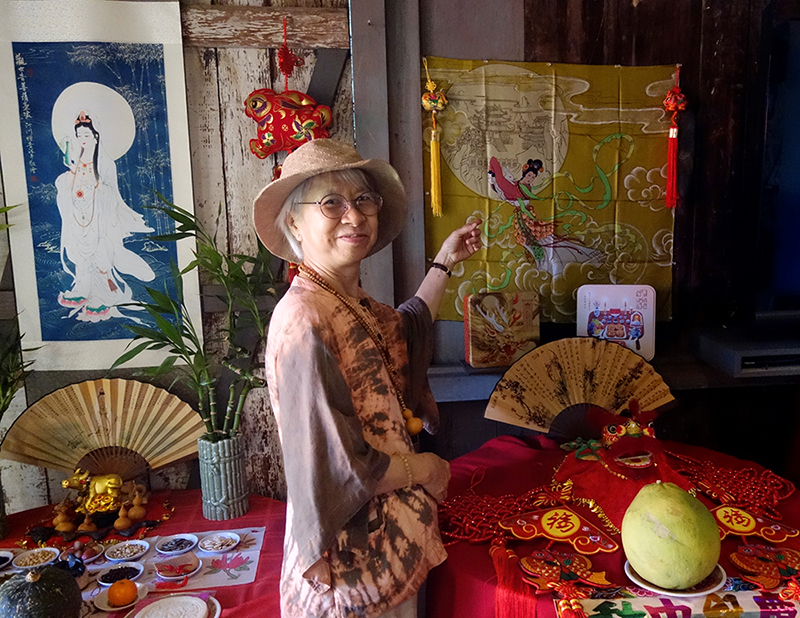
Sep 30, 2020 | Community, Events
 During this time of many health challenges in our life, family, community and the world, it is worthwhile to explore ways to live healthier and happier at home. For example, while we cannot get together for safety reasons, we can still honor seasonal changes and traditions. As Fall approaches, a time of celebration begins in many northern-hemisphere cultures. In Hawaii, one such tradition is the Mid-Autumn Celebration, also known as the Chinese Moon Festival. Honoring the joy of harvest, family and friends reunite during this time of bounty, offering thanks for an abundance of fruits, vegetables and grains.
During this time of many health challenges in our life, family, community and the world, it is worthwhile to explore ways to live healthier and happier at home. For example, while we cannot get together for safety reasons, we can still honor seasonal changes and traditions. As Fall approaches, a time of celebration begins in many northern-hemisphere cultures. In Hawaii, one such tradition is the Mid-Autumn Celebration, also known as the Chinese Moon Festival. Honoring the joy of harvest, family and friends reunite during this time of bounty, offering thanks for an abundance of fruits, vegetables and grains.
“Regretfully, the Chinese Moon Festival usually celebrated at Lahaina’s Wo Hing Temple on Front Street is cancelled this year due to the pandemic,” said Dr. Busaba Yip, Wo Hing Museum Docent and Cultural Director. “However, we can still honor the island’s harvest of locally grown products as well as esteemed traditions from China. One of the most important Chinese festivals, the observance is an ancient tradition commemorating the completeness and abundance of life. It occurs during the harvest moon on the 15th day of the eighth month of the Chinese lunar calendar. The date in the Western calendar changes annually. This year, it falls on Thursday, October 1, 2020.
“It is sad that we cannot have a community gathering this year,” Yip reflected. “Nevertheless, knowing the moon festival’s importance will enhance a celebration of the season at home. For example, people can observe the season with an outdoor service, creation walk or pilgrimage, or prepare meals using the fruits of the harvest season. Many symbolic foods are used to give thanks for the bountiful harvest and to promote fertile fields and bigger crops. One of these foods, the moon cake, is the most distinctive. It is a sweet, round cake in the shape of the moon filled with lotus seeds, taro and black bean paste. Some have salted duck egg yolks at the center of each cake representing the moon. I wish you all a healthy, happy Moon Festival—Zhong Qiu Jie Kuai Le!”
Many thanks to Maui visitors and volunteers for supporting the tradition of the Chinese Moon Festival for our families and future generations.
Dr. Busaba Yip, Wo Hing Museum Docent and Cultural Director
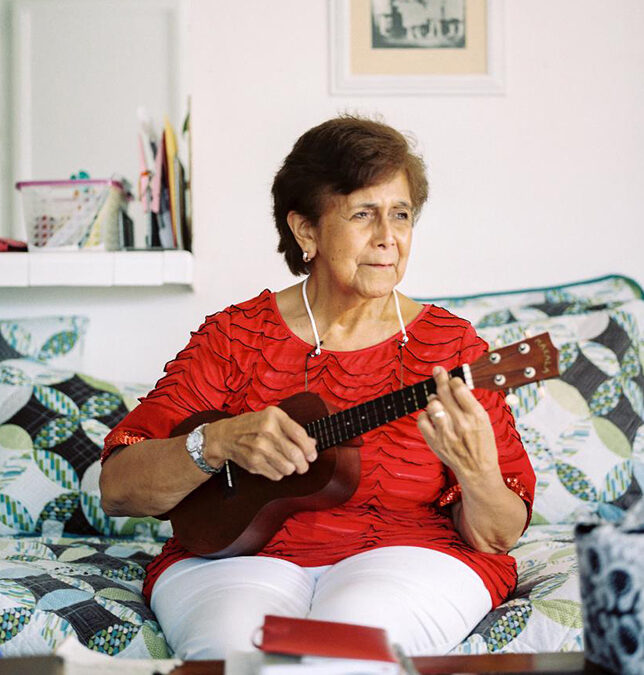
Sep 23, 2020 | Community
 Gabe Amey, founder and director of Our Kūpuna, is concerned about Hawaii’s elderly. “During the deadliest global pandemic our generation has ever seen, I asked myself, how can I help?” said Amey. “This service is that answer. Our Kūpuna was developed to serve a need in the community during a very uncertain time we know as Covid-19. It was launched statewide on March 23, 2020 as a community project started by the team behind Hawaii VA Loans and RISEHI Collective. As an official 501(c)3 nonprofit organization under Hawaii VA Foundation, The mission of Our Kūpuna is to connect Hawaii’s elderly with volunteer sponsors to help them with their daily needs during the pandemic.
Gabe Amey, founder and director of Our Kūpuna, is concerned about Hawaii’s elderly. “During the deadliest global pandemic our generation has ever seen, I asked myself, how can I help?” said Amey. “This service is that answer. Our Kūpuna was developed to serve a need in the community during a very uncertain time we know as Covid-19. It was launched statewide on March 23, 2020 as a community project started by the team behind Hawaii VA Loans and RISEHI Collective. As an official 501(c)3 nonprofit organization under Hawaii VA Foundation, The mission of Our Kūpuna is to connect Hawaii’s elderly with volunteer sponsors to help them with their daily needs during the pandemic.
Unfortunately, not all seniors in Hawaii have ‘ohana on-island to look out for them during these exceedingly difficult times. After orders for residents in the state to stay at home, many kūpuna were isolated, and everyday tasks, such as getting groceries, prescriptions, and other chores have become impossible for them to do alone.
“We are currently serving over 300 kūpuna, 65 years and older, on five islands and we want to get the word out more about Our Kūpuna,” Amey stated. “We need more volunteers. Our staff members do the screening and manage the volunteers. If everything works out, we connect them to kupuna in the area. Our motto, ‘one-to-one’, creates a special relationship with our network of volunteers in the field and the kūpuna they are helping.”
Amey emphasized, “We cannot help everyone, but everyone can help. Kūpuna do not have to pay for this service. It is free. All volunteers and sponsors are doing this to help in the community because so many seniors do not have family on island. The sponsor calls their kūpuna weekly to see if they need any necessary supplies so seniors can stay home. The main purpose of the volunteer service is to ensure kūpuna do not have to battle crowds at the grocery stores or struggle to get to other public places. It is about making sure the elderly have what they need without putting themselves at risk.”
Kūpuna, let us take care of you! For more information visit OurKupuna.com or call (808) 400-4506.
Gabe Amey, Our Kūpuna, Founder and Director
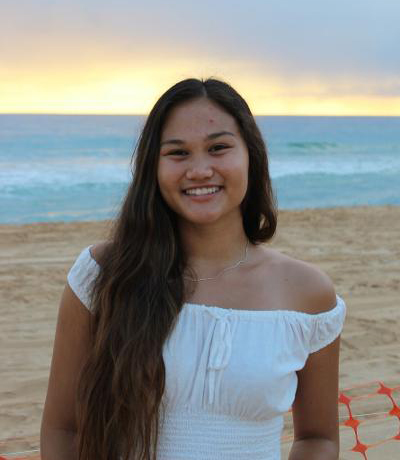
Sep 16, 2020 | Education, Stemworks
 Due to COVID-19, Maui Economic Development Board’s (MEDB) STEMworks™ Summer Internship team strived to personalize work-based learning experiences for students in the new virtual dimensions. They collaborated with internship host companies and community partners to give the students a unique opportunity to explore technical and professional development.
Due to COVID-19, Maui Economic Development Board’s (MEDB) STEMworks™ Summer Internship team strived to personalize work-based learning experiences for students in the new virtual dimensions. They collaborated with internship host companies and community partners to give the students a unique opportunity to explore technical and professional development.
STEMworks Intern Napua Canales, 12th grade, said, “My internship was with BizzyB, a branch of Bizgenics Foundation, a nonprofit organization that fosters creativity, innovation, and entrepreneurship. Specifically, BizzyB is a student innovation platform, where students 13 and older can create market-ready innovation through project-based learning. Our goal as BizzyB interns was to make a project template that other students around the world could use as a guide towards creating their own projects.”
Steve Sue, Bizgenics CEO and STEMworks mentor, explained, “Along with eight other 2020 BizzyB Summer Cohort members, Canales created a first-of-its-kind online project-based curriculum for BizzyB.com. Each student author created a project kit and teaching system for one of the United Nation’s 17 Sustainable Development Goals (SDGs). Canales is the primary author of SDG 11: Sustainable Cities and Communities. These curriculum kits will be featured in the BizzyB application and thus available to the world. Research, writing, graphics and videos are all part of curriculum authoring. This internship is proving that students are more capable and relevant than ever toward reshaping education. As a student voice project, we are clearly seeing that curriculum by students for students is a powerful new paradigm worth exploring. I believe it is part of the future of education. Information technology has changed access to information and perhaps more importantly, gives students more leverage to have larger impact earlier in life.”
BizzyB discovered that the students are really excellent at online research, and they have proven to be highly resourceful in finding content like video clips and authoritative sources that can be integrated in their teaching materials. Canales reflected, “Not only has the internship itself been a great learning experience on how educators create project lessons, we were also given a great learning opportunity on how to improve our work ethic through professional development.”
The summer interns became curators of content and creative coaches with goals of challenging and inspiring others to act while learning.
Napua Canales, STEMworks™ Summer Intern





 Gabe Amey, founder and director of Our Kūpuna, is concerned about Hawaii’s elderly. “During the deadliest global pandemic our generation has ever seen, I asked myself, how can I help?” said Amey. “This service is that answer. Our Kūpuna was developed to serve a need in the community during a very uncertain time we know as Covid-19. It was launched statewide on March 23, 2020 as a community project started by the team behind Hawaii VA Loans and RISEHI Collective. As an official 501(c)3 nonprofit organization under Hawaii VA Foundation, The mission of Our Kūpuna is to connect Hawaii’s elderly with volunteer sponsors to help them with their daily needs during the pandemic.
Gabe Amey, founder and director of Our Kūpuna, is concerned about Hawaii’s elderly. “During the deadliest global pandemic our generation has ever seen, I asked myself, how can I help?” said Amey. “This service is that answer. Our Kūpuna was developed to serve a need in the community during a very uncertain time we know as Covid-19. It was launched statewide on March 23, 2020 as a community project started by the team behind Hawaii VA Loans and RISEHI Collective. As an official 501(c)3 nonprofit organization under Hawaii VA Foundation, The mission of Our Kūpuna is to connect Hawaii’s elderly with volunteer sponsors to help them with their daily needs during the pandemic.
